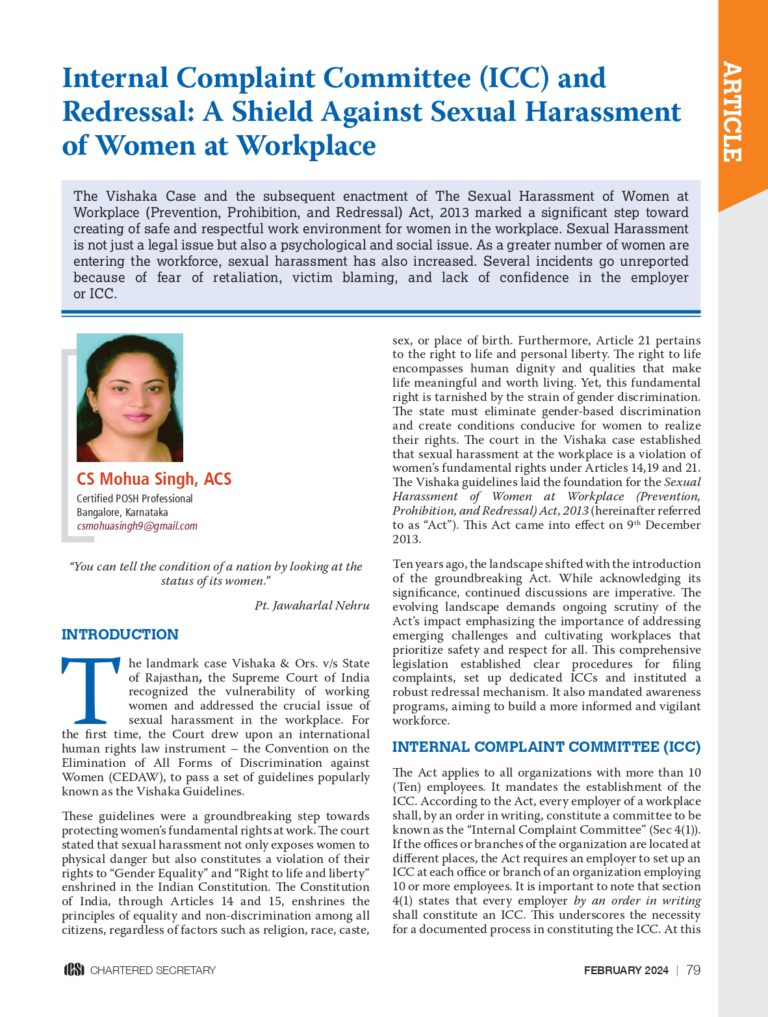Sexual Harassment of Women at Workplace – The Legal Framework
Rights of an aggrieved woman under various Laws
- The Constitution of India. The Indian Constitution guarantees certain fundamental rights to all its citizens. Each incident of sexual harassment at the workplace leads to a violation of one or more than one of the following fundamental rights:
- Equality before law (Article 14)
This Article guarantees every person the right to equality before the law and equal protection of the laws and has been interpreted as a prohibition against unreasonable classification.
b. Prohibition of Discrimination on Grounds of religion, race, caste, sex, or place of birth (Article 15)
According to Article 15(1), the state shall not discriminate on grounds of religion, race, caste, sex, or place of birth or any of them.
Article 15(3) has largely been interpreted as an exception to the principle of non-discrimination guaranteed by Article 15(1). Article 15(3) provides that the state is authorized to make special treatment for women and children and discriminate in favour of them. Under this provision, the state can take progressive measures to protect women from violence and sex discrimination including acts of sexual harassment.
In Government of Andhra Pradesh v. P.B. Vijay Kumar, the court noted the purpose of article 15(3) by stating that “The insertion of clause (3) of Article 15 in relation to women is a recognition of the fact that for centuries, women of this country have been socially and economically handicapped. As a result, they are unable to participate in the socio-economic activities of the nation on a footing of equality. It is to eliminate this socio-economic backwardness of women and to empower them in a manner that would bring about effective equality between men and women that Article 15(3) is placed in Article 15. Its object is to strengthen and improve the status of women. An important limb of this concept of gender equality is creating job opportunities for women. To say that under Article 15(3) job opportunities for women cannot be created would be to put at the very root of the underlying inspiration behind this Article. Making special provisions for women in respect of employment or posts under the State is an integral part of Article 15(3). This power conferred under Article 15(3), is not whittled down in any manner by Article 16.”
“Both Articles 15 and 16 are designed for the same purpose of creating an egalitarian society. As Thommen, J. has observed in Indra Sawhney’s case (supra) (although his judgment is a minority judgment), “Equality is one of the magnificent cornerstones of Indian democracy”. We have, however, yet to turn that corner. For that purpose it is necessary that Article 15(3) be read harmoniously with Article 16 to achieve the purpose for which these Articles have been framed.”
c. Equality of Opportunity in Matters of Public Employment (Article 16)
The main object of Article 16 is to create a constitutional right in equality of opportunity and employment in public offices. Articles 15 and 16 are instances of the same right in favour of citizens in some special circumstances.
Article 16(2) prohibits discrimination on the ground of sex in matters of public employment.
Discrimination on the ground of sex is prohibited under the constitution by a combined reading of the provisions of the “equality code” with Articles 15 and 16 interpreted as facets of Article 14. In State of Kerla v. N.M. Thomas, the Supreme Court of India addressed the question of the appropriate relationship between Articles 14, 15, and 16, holding that Articles 15 and 16 of the Indian Constitution must be seen as facets of Article 14 rather than exceptions to it.
Sexual Harassment in the workplace is a form of gender-based discrimination, impeding women’s ability to engage in their professional activities on an equitable basis with men. The Vishaka judgment and subsequent decisions of the court also acknowledge the impact of such discrimination. Within the framework of gender equality, safeguarding individuals from sexual harassment and upholding the right to work with dignity are integral components, reflecting universally acknowledged fundamental human rights.
d. Right to practice any profession, or to carry on any occupation, trade, or business (Article 19(1)(g)).
All citizens of the country have the right to practice any profession, or to carry on any occupation, trade, or business. Sexual Harassment at the Workplace is a Violation of the Right to Work under Art. 19(1) (g) of the Indian Constitution.
The Supreme Court in Vishaka & Ors vs State of Rajasthan & Ors on 13 August, 1997 held that each incident sexual harassment results in violation of the fundamental rights of ‘Gender Equality’ and the ‘Right of Life and Liberty’. One of the logical consequences of such an incident is the violation of the victim’s fundamental right under Article 19(1)(g) ‘to practice any profession or to carry out any occupation, trade or business’. The fundamental right to carry on any occupation, trade, or profession depends on the availability of a “safe” working environment. Right to life means life with dignity.
e. No person shall be deprived of his life or personal liberty except according to procedure established by law. (Article 21)
The right to life implies the right to live with human dignity and includes those aspects of life that make life meaningful and worth living. Gender discrimination is an obstacle to the full realization of this right. The state has an obligation to eliminate gender-based discrimination and to create conditions and facilities conducive for women to realize their right to economic development while enjoying social and cultural rights. However, in the absence of existing protective mechanisms, the court in the Vishaka case evolved guidelines prescribing sexual harassment at the workplace as a violation of women’s fundamental rights under Articles 14,19, and 21.
In Apparel Export Promotion Council v. A.K. Chopra, the Supreme Court declared the sexual harassment of women is unquestionably incompatible with dignity and honour of women.
In addition to the above provisions in our constitution, we as nation, are also a participating State to the Convention on Elimination of All forms of Discrimination (CEDAW), which requires all State parties to take appropriate measures to eliminate discrimination against women in field of employment. In its General Recommendation, the United Nations Committee on CEDAW clarified that equality in Employment can be seriously impaired when women are subjected to gender-specific violence such as sexual harassment at workplace. The obligation of India under various international treaties are unequivocal.

When can a Writ Petition be filed in sexual harassment?
A victim of sexual harassment may file a writ petition under Article 32 in the Supreme Court and under Article 226 in the High Court in the following circumstances:
- Failure to conduct an Inquiry: A writ petition can be filed against the employer for the failure to conduct a proper inquiry as per the POSH act or Vishaka guidelines against the harasser if sexual harassment was committed.
- Unlawful Termination: If the victim’s services were unlawfully terminated because of a refusal to comply with sexual favour, a writ can be filed against the employer.
- Failure to take action: If the employer fails or refuses to take appropriate action against the harasser after a complaint of sexual harassment is made, the victim can file a writ petition.
- Violation of Principle of Natural Justice: If the committee established in accordance with POSH act passes an order in violation of principles of natural justice, a writ petition can be filed to have the order set aside.
- Failure to follow internal guidelines: A writ petition can be filed when an employer fails to comply with internal guidelines formulated by the organization.
- Transfer Request: In some cases, a victim may file a writ petition for a transfer from the place where the offender works to ensure a safe and harassment-free working environment.
2. The Sexual Harassment of Women at Workplace (Prevention, Prohibition, and Redressal) Act, 2013
Almost 15 years before the implementation of the Sexual Harassment of Women at Workplace (Prevention, Prohibition and Redressal) Act, 2013 it was the Vishaka guidelines which had put the onus of safe working environment on the employer. The Supreme Court while issuing the Vishaka ‘s guidelines under Article 141 of the constitution had observed that these would be binding and enforceable in law until suitable legislation is enacted to occupy the field. The Vishaka guidelines have laid the foundation for the Sexual Harassment of Women at Workplace (Prevention, Prohibition and Redressal) Act, 2013. The Sexual Harassment of Women at Workplace (Prevention, Prohibition, and Redressal) Act, 2013 got the president’s assent on 22nd April 2013 and came into force on 9th December 2013.
The Preamble as contained in the Act states as under:-
“An Act to protect against sexual harassment of women at workplace and for the prevention and redressal of complaints of sexual harassment and matters connected therewith or incidental thereto.
WHEREAS sexual harassment results in violation of the fundamental rights of a woman to equality under articles 14 and 15 of the Constitution of India and her right to life and to live with dignity under article 21 of the Constitution and right to practice any profession or to carry on any occupation, trade or business with includes a right to a safe environment free from sexual harassment;
AND WHEREAS the protection against sexual harassment and the right to work with dignity are universally recognized human rights by international conventions and instruments such as the Convention on the Elimination of all Forms of Discrimination against Women, which was ratified on the 25th of June 1993 by the Government of India;
AND WHEREAS it is expedient to make provisions for giving effect to the said Convention for the protection of women against sexual harassment at the workplace.”
As is suggested from the name given to this Act, it has been made to ensure:
- Prevention
- Prohibition, and
- Redressal of the complaints.
As per the current regime, employers with 10 or more employees are required to constitute an internal committee, conduct training, and awareness sessions, etc. Further, The POSH Act is a Civil Act.
Penalty for non-compliance with provisions of POSH Act.
Where the employer fails to comply with any one of the following he shall be punishable with fine which may extend to Rs. 50,000/-
- Constitute an Internal Committee under section 4(1) of the Act.
- Take action under section 13, 14, and 22, and
- Contravenes or attempts to contravene or abets contraventions of other provisions of this Act or any rules made thereunder.
If any employer, after having been previously convicted of an offence punishable under this Act subsequently commits and is convicted of the same offence, he shall be liable to —
(i) twice the punishment, which might have been imposed on a first conviction, subject to the punishment being maximum provided for the same offence.
Provided that in case a higher punishment is prescribed under any other law for the time being in force, for the offence for which the accused is being prosecuted, the court shall take due cognizance of the same while awarding the punishment.
(ii) cancellation, of his licence or withdrawal, or non-renewal, or approval required for carrying on his business or activity.
... to be continued.




